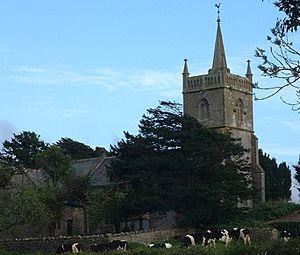Church of St Mary, Nempnett Thrubwell facts for kids
Quick facts for kids Church of St Mary |
|
|---|---|
 |
|
| Location | Nempnett Thrubwell, Somerset, England |
| Elevation | 140m above sea level |
|
Listed Building – Grade II*
|
|
| Designated | 21 September 1960 |
| Reference no. | 1136164 |
| Lua error in Module:Location_map at line 420: attempt to index field 'wikibase' (a nil value). | |
The Anglican Church of St Mary is an old and interesting church located on Knap Hill in Nempnett Thrubwell, Somerset, England. It was built in the 1400s, but there was an even older church from the Norman times (around 1066-1154) on the same spot. This church is considered a very important historical building, known as a Grade II* listed building.
A Look Back in Time
Long ago, before King Henry VIII changed how churches were run in England (this was called the dissolution of the monasteries), this church belonged to a place called Flaxley Abbey in Gloucestershire. In 1537, the land and the church's area were given to a person named Sir William Kingston. The church has kept records of christenings, marriages, and burials since 1568, which helps us learn about people who lived there centuries ago.
What Makes the Church Special?
The church has a tall tower with three main parts. It has strong supports called buttresses that stick out from the walls. There are also two arched openings where the church bells are, decorated with stone patterns called tracery. The top of the tower has a decorative wall called a parapet, with blank arches and square decorations called pinnacles. There's also a slightly taller stair turret on the tower.
The main part of the church, called the nave, was repaired and updated in 1864. This work cost about £700. The back part of the church, called the chancel, was built later in 1897. It is designed in a fancy style known as "decorated." Inside the church, there is a beautiful screen. Some people think it was designed by a famous architect named Pugin, or perhaps his son, Augustus Pugin.
Churchyard Discoveries
Outside the church, in the churchyard, you can find the base of a cross from the 1400s. This cross base is also a listed building, known as Grade II.
In their 1929 book "Somerset," writers Wade and Wade described the church. They mentioned two strange carved heads of a man and a beast on the west side of the tower. They also noted that the walls of the nave still have the original marks from the 1200s, called consecration crosses. These marks show where the church was officially blessed.
The chancel, the newer part, has a beautiful screen and a lovely window with special glass from Munich. They also pointed out a simple Norman-style doorway on the south side. This doorway was later filled with more modern stone patterns. Another interesting feature is a Norman font, which is a basin used for baptisms. It has a curious design carved by someone later on.
Near the porch in the churchyard, you can see the base of an ancient cross. There is also the tomb of the first church leader, named Robert, with a cross carved into it.
See also
- List of ecclesiastical parishes in the Diocese of Bath and Wells

